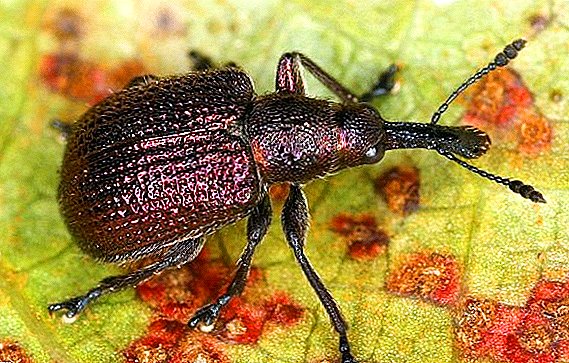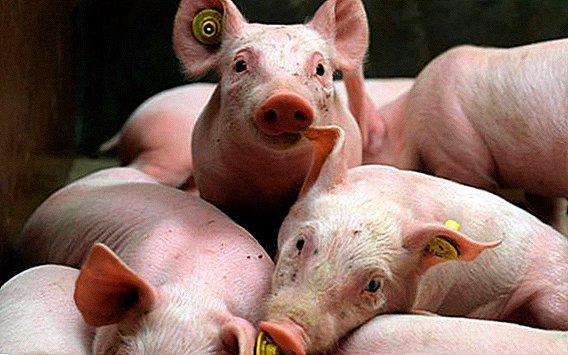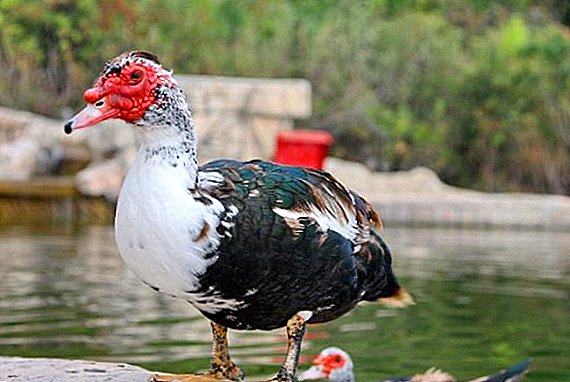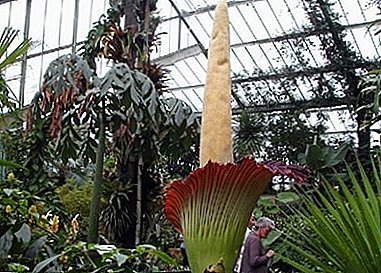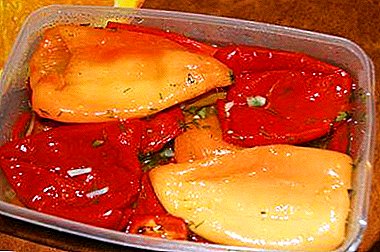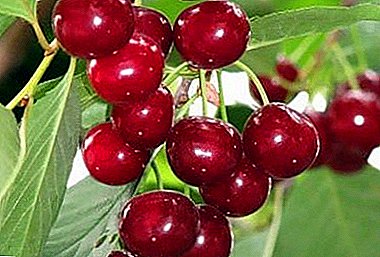
Generous Cherry - one of the most famous and common varieties of bush cherry. The main advantages of this class are frost resistance and productivity.
Despite the fact that the bush varieties are not very durable, Cherry Generous, with timely pruning, able to live and bear fruit for more than 30 years.
 Generous Cherry is hybrid steppe and ordinary Cherries, a full description of the variety and photos can be read and seen later in the article.
Generous Cherry is hybrid steppe and ordinary Cherries, a full description of the variety and photos can be read and seen later in the article.
This is a very unpretentious variety of cherries that do not require special care.
Among the hardy varieties also worth noting Volochayevka, Wreath, griots and Moscow Zhukovsky.
The main rule of cultivation - timely protective processing, fertilizer and proper planting.
Breeding history and breeding region
Generous Cherry appeared as a result random pollination annual seedling varieties Ideal.
The pollination was attended by cherries of various species, including the steppe. Generous was selected as a variety, breeders of the Sverdlovsk gardening station S.V. Zhukov and N.I. Gvozdyukova.
Zoned variety Generous in 1959 in the Urals, Western Siberia and the Volga region.
Often this cherry can be found in the gardens Belarus, Baltic, Ukraine, and outside the post-Soviet space.
In these territories, one can often find such varieties as Lebedyanskaya, Lyubskaya, Malinovka and Mayak.
Appearance of cherry Generous
Consider separately the appearance of the fruit tree and its fruits.
Tree
 it small shrub plant, 1.5-2 m tall, with sprawling branches and upward shoots. The buds are pointed, small.
it small shrub plant, 1.5-2 m tall, with sprawling branches and upward shoots. The buds are pointed, small.
The leaves are oval, long, glossy, saturated green color, with sharp tops and small teeth at the edges. Flowers are white, with a freely arranged petals grow on 3-4 pieces in a single inflorescence.
Fetus
The berries are not very large, weighing 3-5 g, dark red, round, do not crack when overripe. The pulp is slightly watery, with a very pleasant sour-sweet taste and thick cherry aroma.
Youth, Morozovka, Nadezhda and Novella are also distinguished by their excellent taste.
Stone is quite large, easily separated. The stem is long and thin. Fruits are not showered.
Chemical composition.
| Composition | amount |
|---|---|
| Dry soluble substances | 12,2% |
| Sahara | 6,7% |
| Acids | 1,5%, |
| Vitamin C | 13.2 mg / 100g |
| Vitamin P | 318.2 mg / 100g |
A photo





Characteristics of a variety
Generous knowingly received such a name. Generous - very fruitful variety of cherries. From one bush you can get up to 10-15 kg of berries. Fruiting Generous Begins 3-4 year after landing. This cherry blossoms in the last decade of May, and the berries ripen in late August - early September. They ripen at the same time, so the harvest is carried out in several stages.
High yield also exhibit Wreath, Podbelskaya, Ural Ruby and Tamaris.
Generous - self-fruited variety. However, to improve the yield, you can plant a number of pollinating varieties: Polevka, Maksimovskaya, Ural Standard, Subbotinskaya.
 Another indisputable advantage of Generous can be considered very good winter hardiness.
Another indisputable advantage of Generous can be considered very good winter hardiness.
She is can withstand temperatures down to -35 - 45 С without damage to the bark and shoots.
During flowering perfectly tolerates even significant frosts.
Therefore, the variety is recommended for growing it in the northern regions.
Also excellent wintering resistance differ varieties Tsarevna Felt, Ashinskaya steppe, Lyubskaya and Morozovka.
Planting and care
The best time to plant a cherry is spring. Variety Generous undemanding to the composition of the soil, but it is better to use areas for planting on the hills, not flooded, dry, with light sandy soil.
Also the site should be well lit and without shading. For cherry, you have to choose well protected from the north winds places.
You can use diluted with water slurry, in a ratio of 1: 2. And you can make a good rotted manure or compost (15 kg per sq. m).
Be sure to add mineral fertilizers: 80-100 gr. superphosphate and about 50 grams. potassium sulfate per square meter m
 The pits are also prepared in the fall. Dig their depth 40-50 cm and about a diameter 70-90 cm
The pits are also prepared in the fall. Dig their depth 40-50 cm and about a diameter 70-90 cm
At the bottom spread specially prepared soil: the top layer of soil is mixed with the same amount of compost and add 30 grams. superphosphate, 15-20 gr. potassium chloride and about 1 kg of wood ash.
Place a seedling on a hillock in the pit and bury it very tightly. In-depth planting cherry does not tolerate.
The root neck is necessarily left above the soil surface. A pit with high sides, for irrigation, is constructed around the pit.
After landing in this well pour 3-4 buckets of water and be sure to mulch with peat or compost.
When the shrub is planted, during the first two years, the entire care for it consists only in watering, shallow loosening of the soil and removal of weeds. In the fall, the ground around the seedling, carefully, in order not to damage the roots, is dug to a depth of about 10 cm.
In the third year, in the spring, as soon as the snow melts, making the first root fertilizing. For this purpose, nitrogen fertilizers, such as ammonium nitrate or urea. In the fall - superphosphate and potassium sulfate.
When the cherry begins to bear fruit - the number of dressings increase. One half of the norm of nitrogen fertilizers is better to make in the spring, and the second - after flowering.
Organic fertilization is carried out every 2 years, and lime - once in 5 years. Under the autumn digging add phosphorus and potassium.
 The young plant is watered more often as the ground dries. On one watering use about 3-4 buckets of water per square. m
The young plant is watered more often as the ground dries. On one watering use about 3-4 buckets of water per square. m
The frequency of irrigation fruiting cherries reduce up to three times a year. The first time watered the bush immediately after flowering, the second - during the ripening of the berries.
The third watering is carried out under the winter, in October. With a strong drought cherries need to be watered more often. For one such watering use no less than 5-6 buckets of water per square meter.
In addition to fertilizers, irrigation and loosening, bush cherry necessarily hold an annual pruning.
At the beginning of bud swelling, you can see which branches should be removed and which are not. All dry, old and diseased branches are cut and process places of cuts with dense garden pitch.
It is important to remember that the annual shoots in this class can not be shortened. Pruning is desirable to carry out in early spring, before the leafing.
Be sure to remove and unnecessary root growth.which greatly weakens the plant. When pruning it is important to avoid excessive thickening, and promptly remove all branches growing inside the bush. It's not only increase yields, but also significantly reduce the risk of disease.
Diseases and pests
 Generous, though not very often, but prone to such common diseases as moniliosis and coccomycosis.
Generous, though not very often, but prone to such common diseases as moniliosis and coccomycosis.
This cherry is quite resistant to pests, but can sometimes suffer from an attack. mucous sawfly and cherry aphids.
It happens in the period of cool prolonged rains. How to recognize the danger in time and protect the cherry?
Monilioz - A fungal disease that affects the entire plant.
Moniliosis pathogen overwinters in the bark of branches and shoots, and begins to manifest itself only during the flowering of the cherry. First of all, bark, shoots and leaves are affected.
They are covered with thick gray moss, which grows inside the plant and leads to cracking of the bark and complete drying of the branches and leaves. Affected berries quickly rot, dry out and can hang in this form throughout the winter. In this case, the spores of the fungus in them persist until spring.
To get rid of the disease you need to constantly remove infected leaves, shoots and berries, and be sure to burn them. Before and after flowering is desirable process the bush with an aqueous solution of copper oxychloride.
After harvesting, spraying with a 1% solution of the Bordeaux mixture well helps. As a preventive measure, this solution can be used to treat cherries in early spring, before the leaves appear.
 Coccomycosis also a fungal disease, but mainly affects leaves and berries.
Coccomycosis also a fungal disease, but mainly affects leaves and berries.
It can be seen in the initial stage, by the appearance of leaves on the upper part of small red spots.
They grow very quickly and cover all the leaves, and then go to the berries.
The affected leaves fall completely in mid-summer, and the berries dry out. If the disease is not treated, the bush will die next year.
The fungus of coccomycosis overwinters in fallen leaves. Therefore, it is very important to timely clean and burn dry leaves and carefully weed and loosen the soil.
To combat this disease well helps double treatment of the bush and the soil beneath it with 1% Bordeaux mixture or once, after flowering, with copper oxychloride solution.
Resistance to coccomycosis have such varieties of cherries Zhivitsa, Black Large, Rovesnitsa and Fairy.
Slimy cherry sawfly on Generous appears infrequently, but harm can bring considerable. The larvae of this small winged insect feed on cherry leaves. Sawfly females lay eggs on the lower part of the leaves, and after 10-14 days, the larvae appear from them.
You can fight them by regular deep loosening of the land around the plant and the treatment of the bush with insecticides.
 Aphid lays eggs for the winter on the shoots of cherry, near the buds.
Aphid lays eggs for the winter on the shoots of cherry, near the buds.
In early spring, emerging larvae begin to feed on sap of young leaves, and very quickly can destroy the plant.
To combat aphids can use spraying with special preparations or using folk remedies.
This solution is sprayed with a bush before and after flowering. Fortunately, pests are very rarely visited.
The generous variety of cherries in Soviet times was one of the most farmed. He successfully grew in the collective farm and in his own gardens. And today Generous is beautiful suitable for industrial cultivation, and with timely preventive treatment, it grows well in suburban areas.
Advantages of the variety:
- very high and regular yield;
- winter hardiness;
- drought tolerance;
- self-fertility;
- excellent taste and product quality of berries.
 Minuses:
Minuses:
- can sometimes be affected by moniliasis and coccomycosis;
- berries ripen at the same time.
Generous is pretty unpretentious variety of cherries, with many advantages.
He certainly will like amateur gardeners.
Watch the video about the disease of cherry coccomycosis and how to get involved with it.



